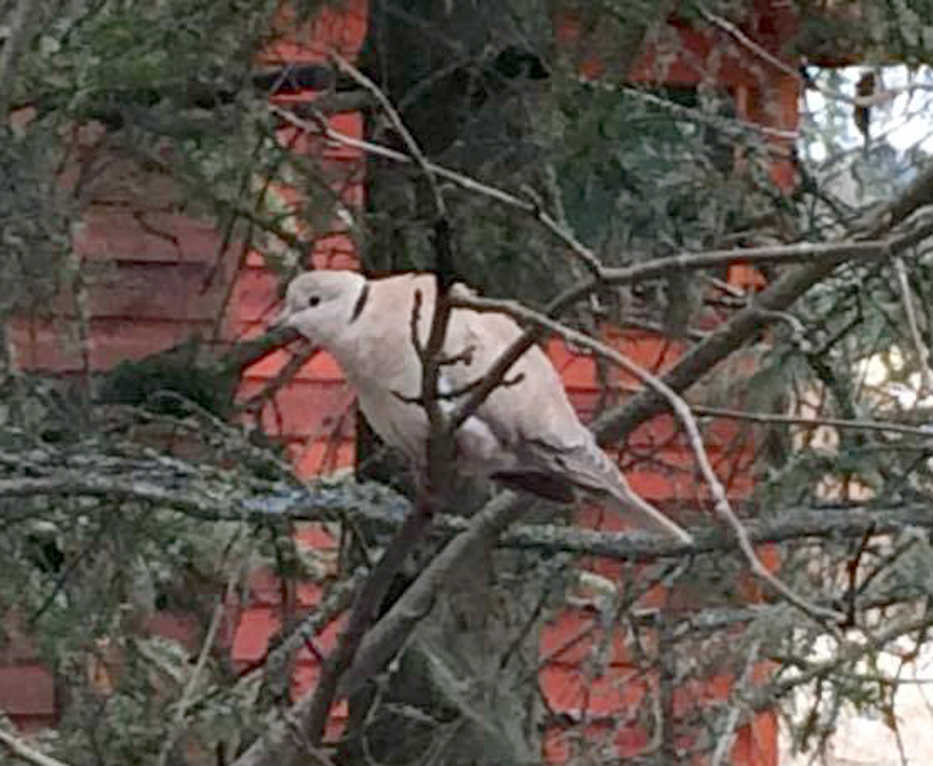Bird watchers come in all flavors from the hardcore lister to the person who casually watches birds at their backyard feeder. One connection that seems to hold true across all levels is the enthusiasm built around seeing a new species that has never been noticed before. The recent sighting of a Eurasian Collared-Dove on Keystone Drive in Soldotna was no exception. The people who spotted it in their yard were excited as they had never seen one before. Several folks called me as they did not have it on their Alaska or Kenai Peninsula list and wondered if it had been resighted.
This excitement is not surprising — this was only the third record ever for this species on the Kenai Peninsula! The first sighting was in 2009 at Peterson Lagoon on the south side of Kachemak Bay. The second dove showed up last June in Seward and was seen by many who travelled from elsewhere on the Peninsula and Anchorage. Ornithologists have been expecting the arrival of this species on the Kenai for a while now and were surprised it took this long.
The Eurasian Collared-Dove is native to Asia and Europe. It was accidentally released in 1974 in the Bahamas. It reached Florida sometime in the 1980s. From there it has made a spectacular spread westward and northward across North America, finally reaching Alaska in less than 3 decades. Every citizen science-based project like the Christmas Bird Count and Project Feeder Watch has documented this prolific invasion.
Viewing the occurrences in eBird (www.ebird.org) gives you a sense of how quickly it was able to spread. Just compare the counties where it was recorded in 1995, 2005 and 2015. As the dove expanded its range, concerns arose about what other birds or other organisms are being impacted by this new invader. It is quite a competitor so species like our native Mourning Dove may be at risk. It is also a known carrier of the protozoan Trichomonas gallinae, though this has not been documented as a major disease problem in the U.S. yet.
So how does it do it? How does this little dove colonize so far away from its native range? Who would have guessed that this warm loving bird species that originated on lands surrounding the Indian Ocean would be able to survive the harsh climate of the boreal forest?
In warmer locales like Florida, the dove lays 2 eggs which hatch a little over 2 weeks later. The young fledge from the nest about 18 days after hatching. Then it does that again and again. Often parents are able to produce 3 to 6 broods per year out of the same nest site. Then these offspring continue the cycle and begin the own reproductive careers after their first birthday.
While there is likely nothing that can be done about Eurasian Collared-Doves in the U.S., it should raise a huge red flag for us. Many species have been accidentally or intentionally released, and many have become common place in our lives like European Starlings and the Common Dandelion. But there are equally dozens of species that are freed every summer in Alaska and fortunately for us do not take off. Alaska is one of the last places in the country where ecological processes are still intact. We have hares eating willows, being eaten by lynx, which are in turn killed by wolves. This food web modifies our natural landscape and is in turn controlled by the landscape.
It would be arrogant to think the loss of one of these cogs — consider Spruce Grouse — in the ecological matrix we call the boreal forest would have no impact or that we could just manipulate the system to accept another substitute. We do our best to document and understand these relationships in nature, but we seem to fail miserably every time we try to change them to benefit us.
So the next time you browse that catalog offering Chukar Partridge and Bobwhite Quail chicks to raise, or perhaps one advertising those beautiful violet Bird Vetch seedlings for your garden, consider how you are going to keep these organisms in control on your property and prevent them from reaching the wild. We will never know which one is the ticking time bomb that takes off or introduces a disease that wipes out one of our native species, permanently compromising the ecological processes that shape our natural world on the Kenai Peninsula.
Todd Eskelin is a wildlife biologist at the Kenai National Wildlife Refuge. Find more information at www.fws.gov/refuge/kenai/ or www.facebook.com/kenainationalwildliferefuge.

